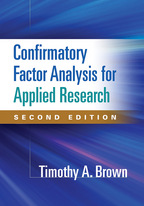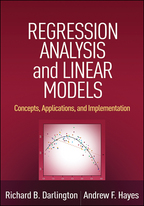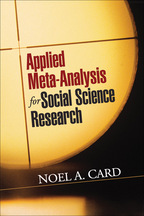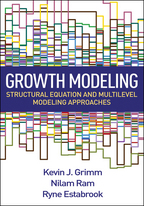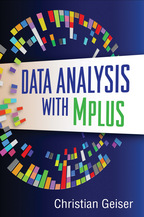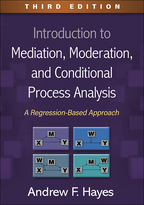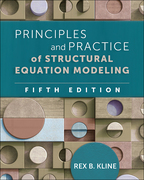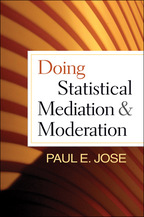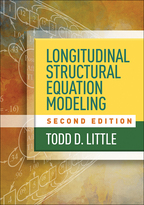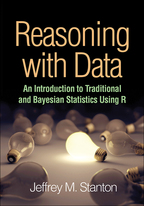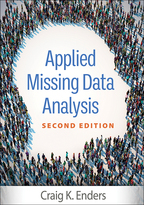Confirmatory Factor Analysis for Applied Research
Second Edition
Timothy A. Brown
Uses of Confirmatory Factor Analysis
Psychometric Evaluation of Test Instruments
Construct Validation
Method Effects
Measurement Invariance Evaluation
Why a Book on CFA?
Coverage of the Book
Other Considerations
Summary
2. The Common Factor Model and Exploratory Factor Analysis
Overview of the Common Factor Model
Procedures of EFA
Factor Extraction
Factor Selection
Factor Rotation
Factor Scores
Summary
3. Introduction to CFA
Similarities and Differences of EFA and CFA
Common Factor Model
Standardized and Unstandardized Solutions
Indicator Cross-Loadings/Model Parsimony
Unique Variances
Model Comparison
Purposes and Advantages of CFA
Parameters of a CFA Model
Fundamental Equations of a CFA Model
CFA Model Identification
Scaling the Latent Variable
Statistical Identification
Guidelines for Model Identification
Estimation of CFA Model Parameters
Illustration
Descriptive Goodness-of-Fit Indices
Absolute Fit
Parsimony Correction
Comparative Fit
Guidelines for Interpreting Goodness-of-Fit Indices
Summary
Appendix 3.1. Communalities, Model-Implied Correlations, and Factor Correlations in EFA and CFA
Appendix 3.2. Obtaining a Solution for a Just-Identified Factor Model
Appendix 3.3. Hand Calculation of FML for the Figure 3.8 Path Model
4. Specification and Interpretation of CFA Models
An Applied Example of a CFA Measurement Model
Model Specification
Substantive Justification
Defining the Metric of Latent Variables
Data Screening and Selection of the Fitting Function
Running CFA in Different Software Programs
Model Evaluation
Overall Goodness of Fit
Localized Areas of Strain
Interpretability, Size, and Statistical Significance of the Parameter Estimates
Interpretation and Calculation of CFA Model Parameter Estimates
CFA Models with Single Indicators
Reporting a CFA Study
Summary
Appendix 4.1. Model Identification Affects the Standard Errors of the Parameter Estimates
Appendix 4.2. Goodness of Model Fit Does Not Ensure Meaningful Parameter Estimates
Appendix 4.3. Example Report of the Two-Factor CFA Model of Neuroticism and Extraversion
5. Model Revision and Comparison
Goals of Model Respecification
Sources of Poor-Fitting CFA Solutions
Number of Factors
Indicators and Factor Loadings
Correlated Errors
Improper Solutions and Nonpositive Definite Matrices
Intermediate Steps for Further Developing a Measurement Model for CFA
EFA in the CFA Framework
Exploratory SEM
Model Identification Revisited
Equivalent CFA Solutions
Summary
6. CFA of Multitrait-Multimethod Matrices
Correlated versus Random Measurement Error Revisited
The Multitrait-Multimethod Matrix
CFA Approaches to Analyzing the MTMM Matrix
Correlated Methods Models
Correlated Uniqueness Models
Advantages and Disadvantages of Correlated Methods and Correlated Uniqueness Models
Other CFA Parameterizations of MTMM Data
Consequences of Not Modeling Method Variance and Measurement Error
Summary
7. CFA with Equality Constraints, Multiple Groups, and Mean Structures
Overview of Equality Constraints
Equality Constraints within a Single Group
Congeneric, Tau-Equivalent, and Parallel Indicators
Longitudinal Measurement Invariance
The Effects Coding Approach to Scaling Latent Variables
CFA in Multiple Groups
Overview of Multiple-Groups Solutions
Multiple-Groups CFA
Selected Issues in Single- and Multiple-Groups CFA Invariance Evaluation
MIMIC Modeling (CFA with Covariates)
Summary
Appendix 7.1. Reproduction of the Observed Variance-Covariance Matrix with Tau-Equivalent Indicators of Auditory Memory
8. Other Types of CFA Models: Higher-Order Factor Analysis, Scale Reliability
Evaluation, and Formative Indicators
Higher-Order Factor Analysis
Second-Order Factor Analysis
Schmid-Leiman Transformation
Bifactor Models
Scale Reliability Estimation
Point Estimation of Scale Reliability
Standard Error and Interval Estimation of Scale Reliability
Models with Formative Indicators
Summary
9. Data Issues in CFA: Missing, Non-Normal, and Categorical Data
CFA with Missing Data
Mechanisms of Missing Data
Conventional Approaches to Missing Data
Recommended Strategies for Missing Data
CFA with Non-Normal or Categorical Data
Non-Normal, Continuous Data
Categorical Data
Other Potential Remedies for Indicator Non-Normality
Summary
10. Statistical Power and Sample Size
Overview
Satorra-Saris Method
Monte Carlo Approach
Summary
Appendix 10.1. Monte Carlo Simulation in Greater Depth: Data Generation
11. Recent Developments Involving CFA Models
Bayesian CFA
Bayesian Probability and Statistical Inference
Priors in CFA
Applied Example of Bayesian CFA
Bayesian CFA: Summary
Multilevel CFA
Summary
Appendix 11.1. Numerical Example of Bayesian Probability
References
Author Index
Subject Index
About the Author

